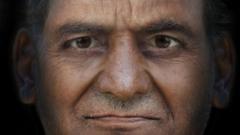

Researchers have successfully recreated the faces of two individuals who lived approximately 2,500 years ago in Keeladi, Tamil Nadu, India. This collaborative project between Madurai Kamaraj University and Liverpool John Moores University employed forensic techniques and CT scans of skulls discovered at a burial site to reconstruct the faces.
The facial reconstructions revealed South Indian features with traces of ancestral West Eurasian (Iranian) hunter-gatherer and Austro-Asiatic people. The skulls were found at Kondagai, a burial site about 800 meters from the main Keeladi excavation site.
The reconstruction process involved several steps. CT scans of the skulls were used to reconstruct the facial musculature and estimate facial features, following anatomical and anthropometrical standards. Digital sculpting techniques were then applied to simulate the placement of muscle, fat, and skin. Researchers estimated tissue depth at various points on the skull, using anthropometric data from modern South Indians. The placement and size of facial features like the eyes, nose, and mouth were estimated based on the skull's characteristics and anatomical relationships. A photographic database was used to assign colors and texture to the skin, hair, and eyes.
Professor Caroline Wilkinson, director of the Face Lab at Liverpool John Moores University, explained that a computer-assisted 3D facial reconstruction system was used. While the upper halves of the faces were reconstructed with greater accuracy using skull characteristics, the lower halves involved more estimation due to missing jaws. Professor G. Kumaresan from Madurai Kamaraj University described the reconstruction process as "80% science and 20% art".
The reconstructed faces, along with DNA data, are expected to provide valuable insights into the ancestry of Tamils who lived during the Sangam age. The study is part of a larger effort by researchers from Madurai Kamaraj University and Harvard University to analyze DNA from Kondagai urns and compare it with global reference populations.
K. Rajan, advisor to the Tamil Nadu archaeology department, noted that this is the first attempt at facial reconstruction in South India. The Keeladi site, where the skulls were discovered, has been a subject of debate regarding its antiquity, with radiocarbon dates ranging from the 6th century BCE to the 2nd century CE. The Tamil Nadu state archaeology department supports the earlier timeline, while the Archaeological Survey of India (ASI) has requested revisions to the findings.